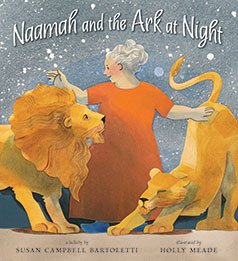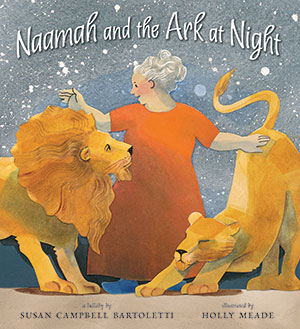Naamah and the Ark at Night

by Susan Campbell Bartoletti
illustrated by Holly Meade
Candlewick Press, 2011
hardcover: 978-0-7636-4242-6
32 pages, ages 4 and up
About the Book
Naamah is the wife of Noah, and her name means “great singer.” For forty days and forty nights, as the ark tosses on storm-wracked seas, Naamah sings. She sings to the animals two-by-two. She sings to her husband, her sons, and their wives. She sings, and they all sleep, finally at peace.
Awards and Recognition
- ALSC Notable
- Booklist‘s Top Ten Religious Books for 2011
- Charlotte Zolotow Honor for picture book writing
- Horn Book Fanfare! “Best Children’s Books of 2011”
- PJ Library Book Selection
- Sydney Taylor Honor
Behind the Book
Strictly speaking, a ghazal (pronounced “guzzle”) comes to us from the Middle East. It’s an Arabic word that means “talking to women.” (How perfect is that meaning for Naamah’s story?)
Here are the basics:
- A ghazal is composed of five-to fifteen stand-alone couplets. (The usual number is seven.)
- Each couplet should be a stand-alone poem in itself that is not linked in any way. (Some poets describe each couplet as a pearl on a pearl necklace.) The refrain provides the link.
- Each line is the same metric length. The first couplet introduces a scheme: a refrain (a repeated word or phrase) that appears at the end of both lines of the first couplet and a rhyme or near rhyme that precedes the refrain.
- Subsequent couplets follow the scheme in the second line only. Here, the refrain is repeated and the second line rhymes or nearly rhymes with both lines of the first stanza.
- The final couplet usually includes the poet’s name and a derivation of the meaning of the poet’s name.
The traditional ghazal is so beautiful! You can find examples by conducting an internet search online.
That said, many Western poets take liberties with the traditional form, and so did I.
One of the biggest liberties is that my ghazal is a continuous development of one subject, Naamah.
To write this poem, I first determined my refrain: night.
Then I determined Naamah’s movement throughout the ark at night. (For me, story comes first.) Then I figured out the rhymes so that they would be organic to her story.
The result? Eleven couplets with rhyming words that move Naamah throughout the ark.
Reviews
A lovely lullaby, in a beautiful, masterfully integrated book. (The Horn Book, starred review)
This captivating interpretation creates a remarkable partner for Noah, who uses her special talent in a memorable way. (Kirkus Reviews, starred review)
Lovely and lyrical … Bartoletti and Meade take a most familiar story and make it breathtakingly new. (Booklist, starred review)
In an author’s note, Bartoletti explains the Arabic poetic form, the ghazal, that inspired the structure of her poetry. Young listeners who hear her bedtime verse will be aware only of its soothing rhythm carrying them to the final ‘Hush hush hush, good night.’ (School Library Journal)
It’s a story of quiet confidence and comfort, during trials of truly biblical proportions, as well as a gentle bedtime book. (Publishers Weekly)



